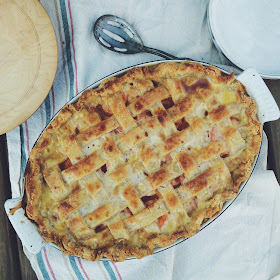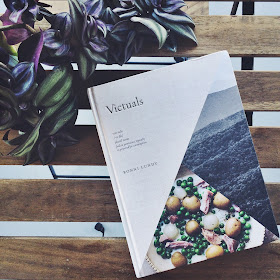As I wrote in a 2012 post featuring a Peach Sonker, a sonker lies somewhere on the spectrum between a deep-dish pie and a cobbler, with a layer of pastry on the bottom, the sides, and or the middle, and generally sporting a lattice top crust. There are numerous varations on this though-- some recipes that lean towards a pandowdy, bearing dumpling that are then covered with the filling. A sonker can be made with any fruit, and there are many that grow well in Surry and Wilkes counties, but peach and sweet potato are favorites. An identifying quality of a sonker is the milk dip, a boiled, sweetened sauce that is partially poured over the crust and filling near the end of baking, with the remainder served on the side as a topping.

I first heard of a sonker in the pages of Nancie McDermott's essential cookbook Southern Pies. When I happened upon it, I had just been to Surry County for the Mt. Airy Fiddler's Convention, capital of the Round Peak style of old-time fiddling. At the time, the only other thing I knew about Mt. Airy was that it was the model for Andy Griffith's Mayberry. If I had made my trip four months later however, I may have swapped the music festival for the annual Sonker Festival, celebrated the first weekend of October. But alas, I made my own introduction, falling in love with Nancie's Peach Sonker recipe and vowing to incorporate it into my regular dessert repertoire.
A few year later, April McGreger's sweet potato sonker recipe in the pages of her Savor the South cookbook reminded me of my sonker love, and I made her version on various occasions. Then last year, my friend Ronni Lundy wrote me, asking if I might create a sweet potato sonker using sorghum, both for her upcoming book, and a spring party at Big Switch Farm in Egypt, Kentucky. Initially Ronni and I were thinking buttermilk for the milk dip, though we were concerned it would curdle during boiling, so we stuck with whole milk.


Sweet Potato Sonker
Adapted from April McGreger's version, and featured in Ronni Lundy's Victuals
Ingredients
Nothing in the House pie crust, doubled
8 Tablespoons (1 stick) unsalted butter, at room temperature, plus more for greasing the baking dish
1/2 cup all-purpose flour, plus more for dusting
6 medium (about 3 pounds) sweet potatoes, peeled
1-2 teaspoons salt, depending on your preference
1 1/2 cups sugar
1 cup sorghum syrup
3 cups whole milk
2 Tablespoons cornstarch
1 teaspoon vanilla extract
Directions
1. 1. Prepare doubled Nothing in the House pie crust as per the directions. Divide the dough into two balls and wrap in plastic wrap. Chill in the fridge for at least 1 hour.
2. Butter and lightly flour a 13x9 inch baking dish (or a dish with an equivalent capacity and at least 2-inches deep). On a floured surface, roll out half of the chilled dough into a large rectangle that will cover the bottom and sides of the baking dish. Transfer the rolled-out dough to the prepared baking dish, and press it down gently to line the dish and form the bottom crust. Place the dish in the fridge to chill.
3. Put the whole peeled sweet potatoes in a large pot, add cold water to cover, and add the salt. Place the pot over medium heat, cover, and bring to a boil. Then reduce the heat to a simmer and cook until the potatoes are fork-tender, about 25 minutes.
4. Use a large slotted spoon to transfer the cooked potatoes to a cutting board to cool. Measure out and reserve 1 1/2 cups of the cooking liquid to use later. Slice the cooled sweet potatoes into rounds, making them as thin as possible without breaking them.
5. Preheat the oven to 375 degrees F. Remove the dough-lined pan from the fridge and layer the sliced sweet potatoes on top of the crust. In a medium bowl, combine 1 cup of the sugar, the sorghum, 1/3 cup of the flour, the butter, and the 1 1/2 cups reserved cooking liquid. Mix well and pour over the sweet potatoes.
6. Roll out the rest of the dough into a rectangle about the size of the baking pan. Cut into strips about 1/2-inch wide and form a lattice crust on top of the sweet potatoes.
7. Bake for about 40 minutes, until the crust is golden brown (the sonker will not be fully baked at this point).
8. While the sonker is baking, prepare the milk dip: Whisk 1/2 cup of the milk with the cornstarch in a medium saucepan, making sure all the cornstarch is dissolved. Add the remaining 2 1/2 cups milk and the remaining 1/2 cup sugar. Set the pan over medium-high heat and let it come to a boil. Let boil for 1 minute to thicken. Then remove from the heat and stir in the vanilla.
9. When the sonker has cooked for 40 minutes. Pour 2 cups of the prepared milk dip over the entire surface. Return the sonker to the oven and bake for 15 minutes more or until it is caramelized around the edges and brown on top. Remove the dish from the oven and let it cool for at least 20 minutes before serving; the milk will continue to be absorbed and thicken.
10. Serve the sonker just warm, with the remaining milk dip on the side for drizzling.

For more of the recipes of this gathering, and for a crucial, deep narrative on the foods of the region, told by one of its best storytellers and champions, I highly recommend picking up a copy of Victuals. Beyond it's inevitable place in the cannon, it's also an accessible resource for daily cooking-- many of the recipes come straight from Ronni's family, and their East Kentucky homeplace and are made from ingredients that are staples in most pantries.
Related recipes:



No comments:
Post a Comment